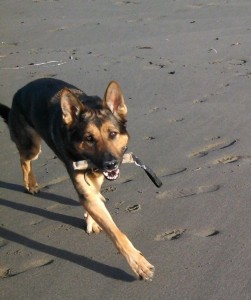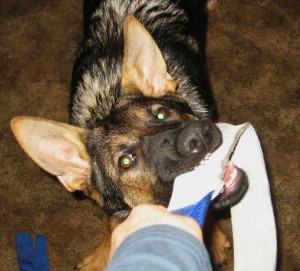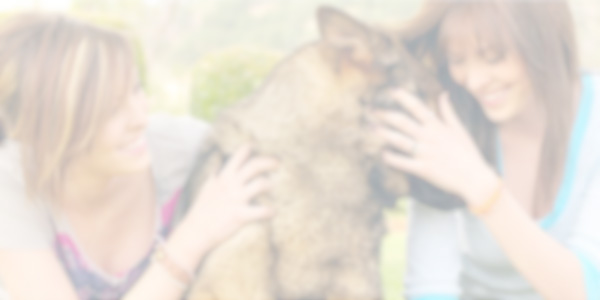Winter Games for You and Your German Shepherd
 Dogs young and old love games! Even older dogs enjoy the short and occasional moments of play; play sessions can keep them active and keep their minds sharp. And for younger dogs, play sessions help burn off excess energy while also engaging the dog’s mind and focusing that energy. For all dogs, playing games with their handler helps develop and improve their relationship, creating a deeper bond and fostering trust and respect.
Dogs young and old love games! Even older dogs enjoy the short and occasional moments of play; play sessions can keep them active and keep their minds sharp. And for younger dogs, play sessions help burn off excess energy while also engaging the dog’s mind and focusing that energy. For all dogs, playing games with their handler helps develop and improve their relationship, creating a deeper bond and fostering trust and respect.
Let the Games Begin!
Now is the perfect time to teach your dog to play some simple and useful games with you! All of these games can be taught through reward-based training, making it enjoyable for both you and the dog alike. These can also be taught indoors, which is a perfect for those extremely cold, snowy, or rainy days that force you all inside. These games listed below are just a sampling of the many different games that you can play with your dog!
Targeting
Targeting teaches the dog to target your hand and/or an object. Dogs proficient at targeting can be sent to touch a target on the opposite wall, or down at the far end of a field (like a send-out). Paw targeting can also be taught, so that the dog learns to place his front and/or back feet on indicated objects. Teaching the dog to target an object to stand on (such as book) can be used for a variety of exercises later, such as teaching the dog to pivot around on his front end. If you have already been performing some of the balance and conditioning exercises in our previous blog, then your dog has been successful in targeting an object with his front (or even rear!) paws.
Teaching a dog to target is relatively simple. One method is to teach the dog to target your open hand. With your dog sitting in front of you, reach down with your open hand, palm toward your dog. Most dogs immediately show interest, thinking they will get a treat. If they make any motion of interest in your hand, whether it is looking at it or sniffing it, reward the interest with a “Yes” (or “click” of a clicker) and a treat. Toss the treat to the side so the dog has to move to get it (allows him to break position and reorient on you again), and then repeat the offering of your hand. Eventually, you will reward only nose touches of the hand. You can then switch hands and work on targeting with your other hand, and then you can put the behavior on cue. You can transition this behavior to other targets after that.
Targeting an object can be taught similarly, but by marking and rewarding any interest in the particular object. The approximations leading up to touching the object with a paw are rewarded, and once contact with the object occurs purposefully, then only contact is rewarded. Use of a food lure can also be helpful in teaching the dog to step up onto a particular object, and can speed along this process.
Go Around
The dog is taught to go around an object at the handler’s direction, such as going around a cone or a chair. This is the foundation for a blind search in IPO, and can be taught incrementally. Start close to the selected object, to set the dog up for success. You can guide the dog around the object first using a treat or toy, rewarding the dog at the moment they come around the object. After several repetitions, the lure can be faded, replaced with just the hand motion. Distance from the object is added after the dog is clear on what “Go Around” means. You can even start practicing around other sorts of objects (so, if you used a chair, try using a box on the floor). Eventually, the dog can be directed to go around a particular object across the room, and can even be taught to go around multiple objects at the handler’s direction (just like a blind search). Even if you don’t plan on training in IPO, it still is a pretty neat trick!
Tug
 A game of tug can be a perfect outlet for excess energy. It also builds overall neck, jaw, and core strength, as the dog uses their entire body in a rousing game of tug. Always keep the tug object low (about level with the dog’s spine), and don’t jerk your dog’s neck upward or to the side suddenly. Encourage them to pull directly backward, and to resist you when you start pulling back steadily. Let the dog win when he tugs strongly, then encourage him to come right back to you for more. Play another round, then ask for an “out” or release. Pause, then restart the game.
A game of tug can be a perfect outlet for excess energy. It also builds overall neck, jaw, and core strength, as the dog uses their entire body in a rousing game of tug. Always keep the tug object low (about level with the dog’s spine), and don’t jerk your dog’s neck upward or to the side suddenly. Encourage them to pull directly backward, and to resist you when you start pulling back steadily. Let the dog win when he tugs strongly, then encourage him to come right back to you for more. Play another round, then ask for an “out” or release. Pause, then restart the game.
Be sure to use a durable toy that is designed for tugging. Jute or suede rolls and tugs work very well. Many of the commercial “chew toys” on the market do not have the ability to withstand tugging; they often are not designed well for the actual tugging exercise, either. The toys used for tug should be of a safe and durable material that “gives” and allows the dog to get a good grip. The tug should also not be so fat that the dog cannot close his mouth on it strongly, nor made of material that can shred easily and catch the dog’s teeth.
Scent Games
A variety of scent games abound! Examples include: “find the hidden treats”, specific article indication or retrieves of only the objects you have touched (such as the scent discrimination exercise in AKC obedience), tracking of specific family members, or specific nosework games, where the dog is trained to indicate various scents.
One simple and exciting scent game to play is the Box Game. This is a precursor to Nosework exercises. It is also a great way to use some of those cardboard boxes you have laying around in the garage! It is also low-key enough to use with dogs that have sustained an injury or are in recovery from surgery or illness. The goal of the Box Game is to teach the dog to indicate the boxes with food inside them. You can set out several boxes and place a food drop inside one of them. Bring the dog along and let him sniff the boxes, and when he shows particular interest in the food box, mark and reward. You can shape the indication you want (a sit, a down, a bark), and reward this indication with a toy or food. You can add scent discrimination with the food later, pairing a particular scent with the boxes that have food in them (in Nosework, some scents include Birch, Anise, and Clove) . Later, you fade the food until the dog is indicating on only the scent. You can increase the number of boxes with food, alter their positions (put some on chairs, others on the floor, etc.), or even add in other containers of various shapes and sizes. Later, you can place the scents (usually they are cotton balls with the scent on them) in trickier and trickier places around the house, garage, or even outside.
These are just a few of the different games you can play with your German Shepherd Dog. Pick a game, grab a tug and some treats, and go play with your dog!

